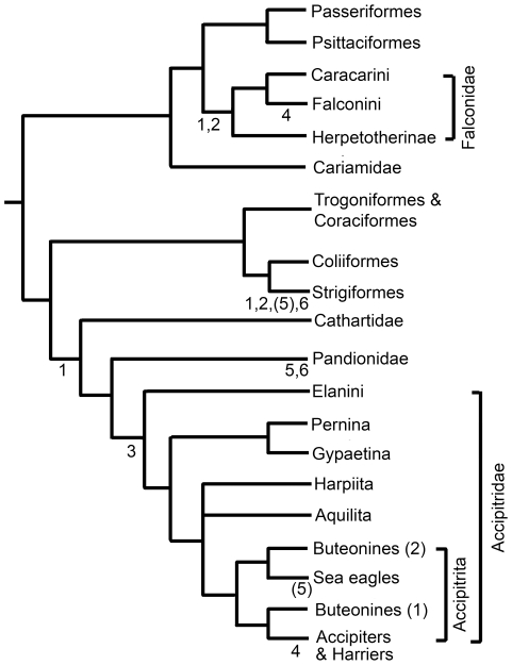Bone Dropping Bearded Vultures
Biology 342 Fall 2012
Ivy Hellickson
Phylogeny
The Bearded Vulture may not be exactly fit what one usually expects when they think of vultures. Where's the bald head? What about the waxy black feathers? Bearded Vultures look very different than the more familiar Turkey Vulture, and evolution is responsible for this difference!
This is because the Bearded Vulture is considered "Old World Vultures", meaning that they range across Europe, Asia and Africa. They locate prey using their vision, and feed primarily on carrion. This category of vulture and the "New World Vultures" in the Americas have acquired similar traits via convergent evolution [5]. Bearded Vultures belong to the subfamily Gypaetinae, which is a group that occurs rather early in the phylogentic tree of the Acciptridae family.
All of this, however, is just the general phylogeny of the Bearded Vulture. The question to now be addressed is, how did their unique bone-dropping behavior come to be? Does it have an evolutionary basis? Could it also be a result of some kind of convergent evolution like that resulting in the similarities between new and old world vultures?

Figure 3. Phylogenetic tree of raptors based on the occurence of morphological traits [6].
The Bearded Vulture shares many physical characteristics with its close relatives the Egyptian Vulture and the Palm-nut Vulture, such as plumage style and coloration. Although the Bearded Vulture is the only one to feed primarily on bone marrow, all three of these species have specialized diets. Fruit, feces, turtles and ostrich eggs are all on the menu [6]. Also, just as the Bearded Vulture drops its meal on rocks to access the nutritious inner nutrition, the Egyptian Vulture has been observed using objects such as rocks to break ostrich eggs.
Even more distantly related birds, such as Bald and Golden Eagle which belong to the subfamily Accipitrinae, have been known to drop food sources onto rocks to break them open [13].Because all of these birds are within the same family, Accipitridae, it suggests that at least some part of this behavior is evolutionarily based. However, these rather related bird species are not the only birds that show this behavior.
The subfamily Corvidae, which includes crows and ravens, have also been observed using intelligent techniques to obtain hard-to-access food. Crows often perch somewhere above trafficked area and drop nuts or other shelled food sources onto the road and wait for cars to run the nuts over and crack them open. Both Accipitridae and Corvidae evolved more recently than the family Gypaetus, suggesting that this extreme learning ability could have an early evolutionary basis, but convergent evolution most likely played a factor. This is especially true of the family corvidae, which in Fig. 3 is in the order Passeriformes, is very evolutionarily distant from the family Accipitridae.
Convergent evolution is the process by which two different species of organisms that are not related (or are distantly so) evolve similar traits because they are exposed to similar pressures. Therefore, birds like crows and others from the family Corvidae most likely evolved the behavior of crushing and breaking difficult items because they, like birds from the family Gypaetus, were affected by pressure like food scarcity. Therefore, those individuals that were able to access relatively untapped food sources such as nuts or turtles were able to better increase their relative lifetime fitness. Because these individuals survived better, they were able to pass on their genes and their offspring were more pre-disposed to the behaviors that allowed their parents to get at difficult food supplies.


Figure 4. An Egyptian Vulture using a stone to break an Ostrich Egg [16]. Figure 5.A crow perched on top of a powerpole above traffic with a nut in its beak [17].
Although the specific methods of obtaining food are most likely learned behaviors as they are characteristic of seperate species, the generally broad variety of food in these birds' diets and their capacity to learn so effectively is a trait shared amongst the early subfamilies of the bird family Accipitrida, such as those including Bearded and Egyptian Vultures, as well as more recently evolved families that include eagles and crows.
The behavior itself probably evolved after the vultures began to fill the bone-eating niche. Eating smaller bones or more fragile ones provided the birds with nutrition, but those individuals who then began dropping the larger bones were able to access even more of that sustenance. Therefore, these birds had a higher overall fitness, leading to an increased reproductive fitness.